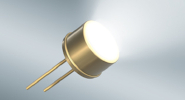
High-speed data transmission
High-speed data networks spanning the globe
Demand is on the rise for more powerful networks, especially Ethernet. At the same time, data transmission demands are disproportionately expanding. Information must be available on a constant basis, and the amount of material traveling along in the digital journey is also constantly rising. “Rampant video sharing more than anything else is driving demand for technological leaps,” says Robert Hettler, Head of Optoelectronic Component Development at SCHOTT.Hettler and his team recently launched the 50G transistor outline housing (TO), a packaging solution for fiber-optic data transmission components that enables unprecedented transmission speeds. “The decisive question in wired data transfer is how much can you transport over a single fiber,” explains Hettler. As the name suggests, the new TO from SCHOTT enables 50 gigabits per second, twice as much as before.
Fiber optic high-frequency data transmission uses a transmitter (laser) on one side of the line and a receiver (photodiode) on the other (see graphic). Both components are packaged with a TO, which protects them from external influences – primarily humidity. The electronic packaging expert explains that a data line can, of course, achieve significantly higher transmission rates, but the problem is signal transitions, such as connections to the circuit board and chip. All transitions must be optimally designed to achieve a performance of 50 gigabits per second.
SCHOTT TO Plus® packages for up to 50 Gbit/s
Since components vary from customer to customer, SCHOTT offers individual solutions. “When developing our TO, we always take into account who will use our package and how. One customer might need a larger mounting surface for a laser while another wants to push the pin a little further up to the left. The best TO in the world is useless if it is incorrectly connected,” says Hettler. Three points were addressed from the outset to becomes the first manufacturer to achieve the new TO standard: How can the PCB connection be improved to reduce losses? How can tolerances be reduced, such as in the glass fill level, and how can the internal chip connection be optimized to improve performance?Directly modulated TOs, like the new 50G version, don’t require any extra components for lighting control and offer the best price/performance ratio in optical high-frequency data transmission. They enable telecommunications providers to bring optical fibers as close as possible to the end consumer at low cost. The catchphrase here is “fiber to the home.” And thanks to the faster connection, more customers can be supplied with data on an existing line than ever before.
50 gigabits is far from the end of the line. In conjunction with the PAM4 process, up to 100 gigabits per second can be transmitted over a single fiber. This is possible because the modulation not only switches the light on or off, but turns it one-third, two-thirds and all the way on. This results in four power levels with which two bits can be digitally transmitted.
Supporting the fastest and most efficient transmission speeds for telecom networks and data centers
This speed frenzy raises the inevitable question of where it is all leading. “Technically, transfer rates over optical fibers can be increased by more than a thousand times. An end to this development is far from in sight.” Hettler is certain that companies like Google and Amazon will continue offering products demanding faster and faster transfer rates.And this is where we come to mobile networks. They have long outstripped stationary devices. Here, too, the 50G-TO supports data acceleration and drives forward the introduction of 5G mobile radio networks. After all, transmission towers also need to be reliably supplied with data so that they can forward them it efficiently. Future applications like autonomous driving will not a millisecond’s delay.
The new TO is just one more way SCHOTT is setting new standards in packaging solutions for high-speed network technologies. The company launched the first 10 gigabit TO in 2002, a 14G version in 2008, five years ago 25G, and now 50G. Hettler: “We’re already working on further expansion stages.”



